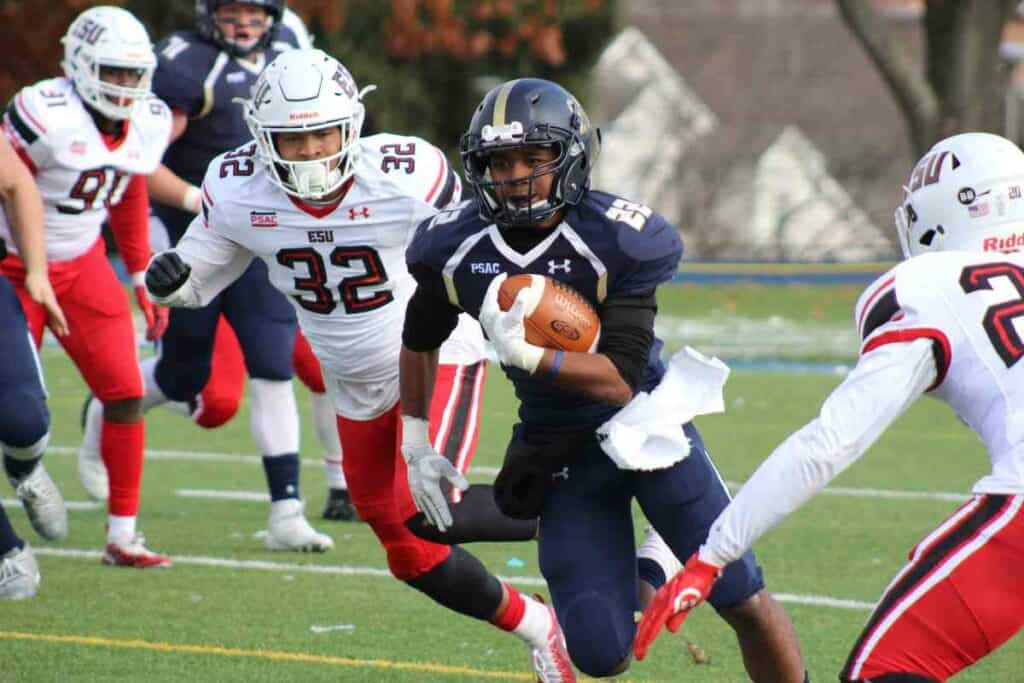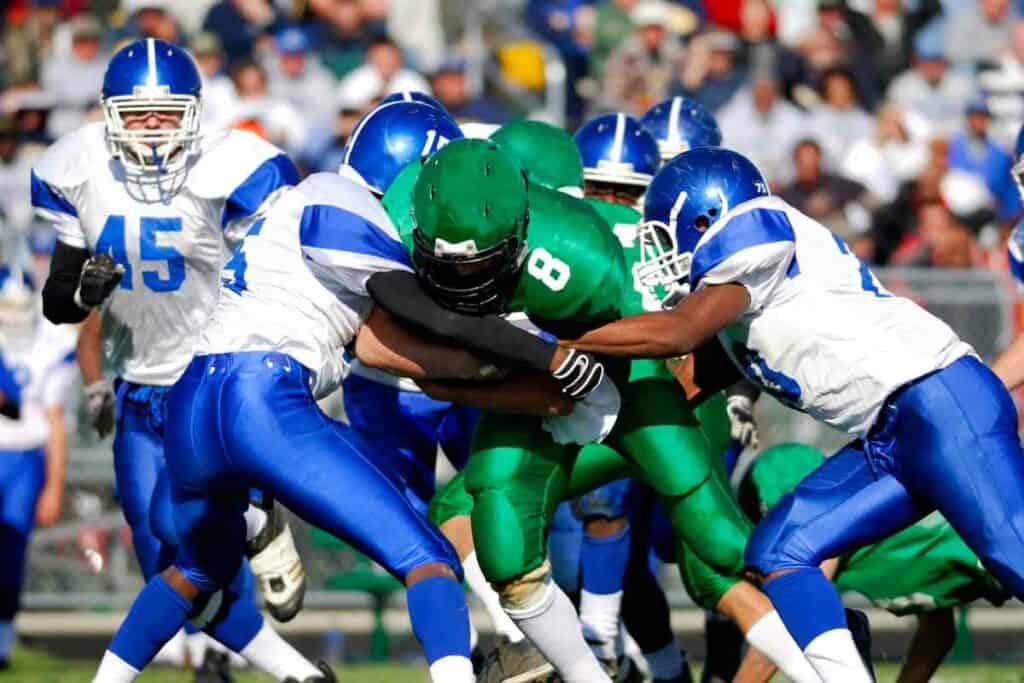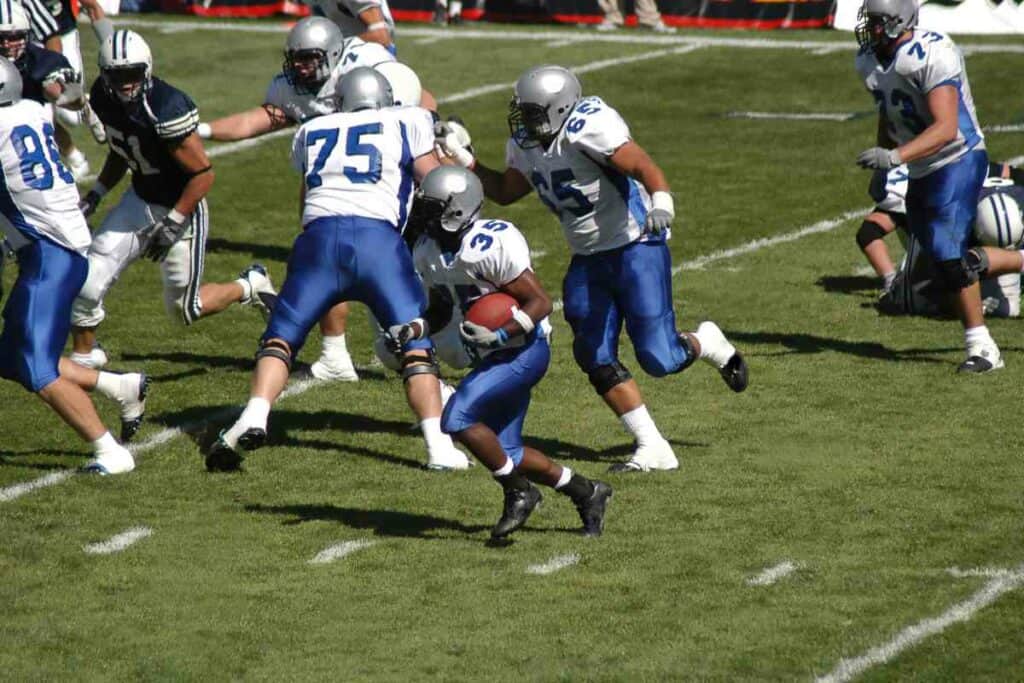Can You Assist the Runner in High School Football? Essential Support Roles Explained

In the dynamic world of high school football, the concept of “assisting the runner” often sparks discussion among enthusiasts and participants. This debate centers around the legality and ethics of players pushing or pulling a teammate to further advance the ball.
Related Post! High School Football Blocked Field Goal Rules
Can You Assist the Runner in High School Football?
In high school football, according to the National Federation of State High School Associations (NFHS) rules, players are not allowed to physically assist the runner by pushing or pulling them to advance the ball. This ensures fairness and safety during the game, adhering to the structured regulations of play.
While the spirit of teamwork is fundamental to football, the National Federation of State High School Associations (NFHS) enforces specific rules to regulate physical assistance among players during gameplay. These regulations aim to maintain both the fairness and safety of the sport, underscoring the importance of adhering to the guidelines to ensure competitive integrity and promote strategic gameplay and player growth.
Key Insights:
- The NFHS meticulously regulates assistance to runners in high school football to uphold the game’s fairness and safety.
- Familiarity with these rules is essential for strategic planning, ensuring teams play within the bounds of fairness while optimizing their gameplay strategies.
- The regulations surrounding runner assistance significantly influence player development and overall team dynamics.
Exploring the Runner’s Role
A runner’s role is central to a team’s offense, requiring a multifaceted skill set for effective field navigation and scoring opportunities.

Key Skills and Responsibilities:
- Vision: Runners need exceptional awareness to identify gaps in the defense and predict opponent movements.
- Agility: The ability to swiftly change direction is crucial for dodging tackles.
- Ball Handling: Maintaining a firm hold on the football is key to minimizing turnovers.
Runners are indispensable, tasked with piercing through defensive lines and propelling the team forward. Their role demands not just physical prowess but strategic acumen, as they interpret defensive setups and make instantaneous decisions to safeguard possession and maximize yardage.
Related Post! How Does High School Football Overtime Work?
Focused Fitness and Training Regimen:
To thrive in this role, runners engage in comprehensive training that enhances their strength, speed, and endurance.
- Strength Training: Building core and leg strength to withstand tackles and enhance balance.
- Sprints: Developing rapid acceleration to surpass defenders and create offensive opportunities.
- Endurance: Cultivating the stamina required to perform consistently from kickoff to the final whistle.
This holistic approach to fitness ensures runners possess not only the speed to outrun opponents but also the resilience to maintain high performance levels throughout the game. Integrating sprints and endurance work into their regimen prepares them for the demands of prolonged efforts, enabling them to make pivotal plays even in the game’s closing moments.
Preparation Strategies for Runners
As the high school football season approaches, it’s imperative for runners to hone their physical and mental readiness through dedicated training, nutritional diligence, and injury prevention strategies. These efforts ensure peak performance when it counts most—on game day.
Pre-Season Preparation
The onset of the season calls for a strategic buildup of endurance and strength, carefully balancing workload to lay a robust foundation while avoiding burnout.
- Base Mileage: Gradually increase weekly running distance to enhance endurance safely.
- Strength Training: Focus on core and leg strength exercises to bolster power and stability.
- Speed Work: Integrate interval training and tempo runs to elevate cardiovascular efficiency.
Nutrition and Hydration Essentials
Optimal performance is fueled by more than just physical training; it requires attentive nutrition and hydration practices.
- Consistent Hydration: Maintain hydration throughout the day, not limited to workout sessions.
- Nutrient-Rich Diet: Ensure a balanced intake of carbohydrates, proteins, and fats for energy and recovery.
- Meal Timing: Strategically plan meals to fuel pre-workout energy and post-workout recovery.
Injury Prevention Tactics
Proactively addressing injury risks is crucial for maintaining consistent training progress and readiness for game day.
- Dynamic Warm-Ups: Employ dynamic stretches to enhance flexibility and reduce injury risks.
- Attuned Rest: Heed the body’s signals for rest to prevent overuse injuries.
- Post-Workout Recovery: Emphasize cool-down stretches to facilitate muscle recovery and reduce soreness.
Related Post! How Does The Game Clock Work In High School Football?
Maximizing Game Day Performance

Game day success is the culmination of meticulous physical preparation and mental focus, underscored by effective communication among teammates.
Effective Warm-Up Routine
- Dynamic Stretching: Implement movement-based stretching to prepare the body and mind.
- Position-Specific Drills: Conduct short, focused drills to prime position-related skills.
- Team Cohesion Drills: Engage in light team exercises to simulate game scenarios.
Mental Preparation Strategies
- Visualization: Dedicate time to mentally rehearse successful plays and personal performance.
- Breath Control: Utilize deep breathing to maintain calmness and focus.
- Pre-Game Rituals: Establish a ritual to signal the transition into game mode.
On-Field Synergy
- Hand Signals: Utilize predetermined signals for quick in-game adjustments.
- Efficient Huddle Communication: Keep huddle discussions brief and clear for immediate play execution.
- Non-Verbal Cues: Leverage eye contact and other non-verbal signals for silent coordination.
Adhering to these comprehensive strategies enables high school football runners to enter the season with confidence, ready to tackle the challenges and opportunities that each game presents, with the ultimate aim of achieving personal and team excellence.
Strength and Conditioning

In high school football, the implementation of comprehensive strength and conditioning routines is pivotal for enhancing performance on the field and reducing the likelihood of injuries. A balanced program integrates weight training for muscular strength, agility drills for quickness and coordination, alongside endurance workouts to maintain performance intensity from kickoff to the final whistle.
Weight Training Essentials
Focusing on compound exercises facilitates the development of power necessary for tackling, blocking, and sprinting effectively:
- Squats: Key for bolstering leg and core stability.
- Bench Press: Enhances upper body strength crucial for physical confrontations.
- Deadlifts: Targets overall body strength, emphasizing the back and legs.
Agility Training
Incorporating agility drills is crucial for improving maneuverability on the field:
- Ladder Drills: Elevates foot speed and coordination.
- Cone Drills: Enhances quick directional shifts, boosting agility.
- Shuttle Runs: Increases acceleration and deceleration skills.
Endurance Building
Sustaining energy throughout the game demands targeted endurance exercises:
- Interval Training: Combines sprints with jogging to improve both aerobic and anaerobic capacity.
- Steady-State Cardio: Longer, moderate-intensity runs build foundational stamina.
- Circuit Training: Executes a series of high-intensity exercises to condition the body against fatigue.
Related Post! Advancing The Fumble: The Rules Of High School Football
Continual Development Strategies
Adhering to and understanding the rules around assisting the runner necessitates ongoing improvement, achieved through detailed feedback, focused practice, and off-season commitment.
Feedback and Tactical Analysis
Post-game evaluations and discussions offer insights into adhering to assistance rules:
- Game Footage Review: Analyze plays to identify instances of potential runner assistance.
- Referee Consultations: Understand officials’ perspectives on in-game actions.
Skill Enhancement Drills
Practice drills designed to refine rule adherence and improve independent playmaking:
- Non-contact Practice: Focus on evasive maneuvers without the need for assistance.
- Rule-focused Scenarios: Simulate game situations close to assistance boundaries to fine-tune legal play execution.
Related Post! Can You Face Guard In High School Football?
Off-Season Preparation
Dedicated off-season activities can significantly impact rule compliance and physical readiness:
- Targeted Strength Training: Emphasize exercises that boost the runner’s capability to withstand tackles solo.
- Rule Familiarization: Regularly review NFHS rules to stay informed on legal play and rule interpretations.
By emphasizing these key areas within a strength and conditioning program, high school football players can not only elevate their game performance but also ensure their actions remain within the framework of the rules, fostering a competitive yet fair play environment.
